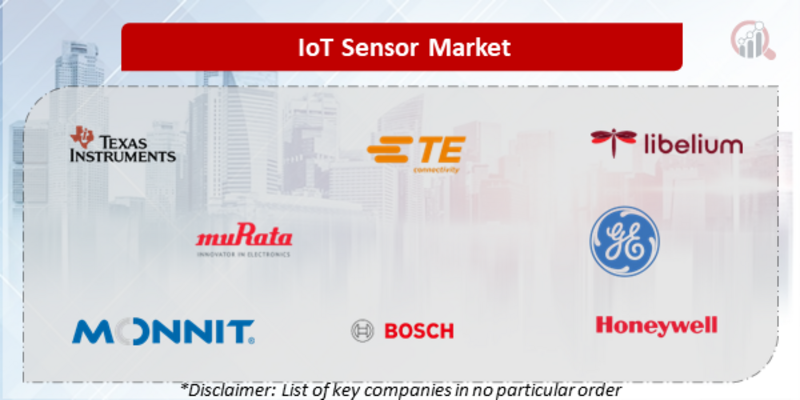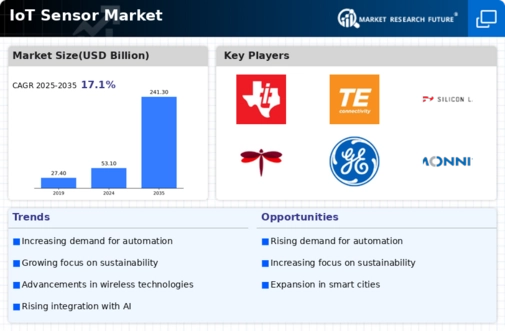Top Industry Leaders in the IoT Sensor Market

The Competitive Landscape of the IoT Sensor Market
The Internet of Things (IoT) hums with the silent orchestra of countless sensors, whispering data about temperature, pressure, movement, and a myriad of other environmental factors. In this symphony of intelligence, the IoT sensor market plays a crucial role, acting as the ears and eyes of the connected world. Understanding the competitive landscape of this dynamic market is crucial for navigating its potential and composing a melody of success in the connected universe.
Key Player:
- Texas Instruments
- TE Connectivity
- Silicon Laboratories
- Libelium
- Murata Manufacturing
- General Electric
- Monnit
- Bosch Sensortec
- Smart Things
- Honeywell
Strategies Adopted by Leaders:
- Technology Prowess: Bosch and Texas Instruments lead the charge with high-precision sensors, robust connectivity options, and low-power consumption, setting the benchmark for reliability and scalability.
- Vertical Specialization: Honeywell focuses on industrial applications with rugged sensors for harsh environments, while Sensirion caters to smart home solutions with miniaturized temperature and humidity sensors.
- Partnership Play: Amazon Web Services (AWS) collaborates with sensor manufacturers and system integrators, fostering co-development and accelerating platform adoption.
- Open-Source Platforms: The Eclipse Foundation's Californium project promotes open-source development tools for IoT sensors, lowering entry barriers and empowering new players.
- Security and Privacy Focus: Cisco Systems prioritizes strong data encryption and secure connectivity protocols, addressing critical concerns in data-driven environments.
Factors for Market Share Analysis:
- Sensor Performance and Accuracy: Companies offering high-precision sensors, wide detection ranges, and reliable data streams command premium prices and secure market share by enabling accurate data collection and valuable insights.
- Connectivity and Interoperability: Seamless integration with diverse communication protocols and compatibility with various IoT platforms are essential for widespread adoption and scalability.
- Power Consumption and Battery Life: Energy-efficient sensors and low-power communication technologies are crucial for battery-powered devices and remote deployments.
- Size and Form Factor: Miniaturized, low-profile sensors that easily integrate into existing systems are preferred for diverse applications, particularly in the consumer market.
- Cost Competitiveness and Affordability: Balancing advanced features with an attractive price point is crucial for capturing market share in price-sensitive segments, particularly in emerging markets.
New and Emerging Companies:
- Startups like The Things Industries and Helium: These innovators focus on low-power wide-area networks (LPWANs) for long-range connectivity in remote areas, addressing challenges in rural and sparsely populated regions.
- Academia and Research Labs: MIT's Auto-ID Lab and Stanford University's Center for the Internet & Society explore novel sensing technologies, biomimetic sensors, and ethical considerations in IoT applications, shaping the future of the market.
- Niche Sensor Specialists: Companies like SensiQ Technologies and Physion develop advanced gas sensors and biosensors for environmental monitoring and personalized healthcare, addressing specific industry needs.
Industry Developments:
Texas Instruments:
- November 2023, Launched a new family of ultra-low-power environmental sensors for battery-powered IoT devices, extending device lifetimes and reducing maintenance needs.
- July 2023, Announced a collaboration with a cloud software provider to offer pre-packaged IoT solutions featuring TI sensors and cloud-based data analytics.
TE Connectivity:
- October 2023, Introduced a series of miniaturized pressure and temperature sensors specifically designed for harsh industrial environments.
- December 2023, Partnered with a leading agricultural technology company to develop integrated sensor solutions for precision agriculture applications.
Silicon Laboratories:
- September 2023, Unveiled a new low-power multi-sensor platform combining motion, temperature, and humidity sensing capabilities in a single chip.
